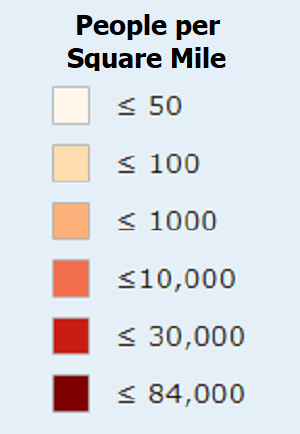
Select the way you want to see the data shown. Then, click on any county to learn about its population density.
Population density is a measure that combines several facts about where and how people live. It can be used to differentiate urban vs. suburban vs. rural regions. It can be used as a factor to try to explain a wide range of other population measures, such as income, politics and access to healthcare. Population density is calculated by first defining an area, whether it is outlined by political boundaries or by boundaries defined for other reasons. An example of the latter are "census tracts," devised by the US Bureau of the Census decades ago to provide an effective framework for the redistricting of US House of Representatives every 10 years and adapted for many other uses since then. Census tracts are of widely varying sizes because they contain relatively consistent populations.
For one example of its ability to describe where people live, population density measures the relative ground distance between people's residences. Taller residential buildings that are more likely to be found in larger cities reduce that distance tremendously. So do city blocks of row homes with small to non-existant backyards. The key attraction for those leaving cities and smaller towns for suburban housing developments starting in the 1950s was the separation between dwelling units while keeping the neighborhood-based lifestyle. Rural living, whether on farms or in forested landscapes or even desert areas, feature the maximum distances between dwellings.
A similar, but not identical, distinction that describes where people live is the difference between the three types of municipalities in Pennsylvania: cities, boroughs and townships. As noted above, cities generally have the largest relative populations in their counties and likewise, the largest population densities. Boroughs represent an urban development usually smaller than cities (but no less densely populated, as the table below shows). And finally townships are mostly rural, except when they are immediately adjacent to cities and boroughs.
Another example that demonstrates how population density shows how people live is how it reflects family size. Homes with larger numbers of occupants will, of course, increase population density, and vice versa. Family size can reflect the ages of members of the household. Areas with higher median ages will have smaller numbers of members of households, and areas with larger numbers of children in most families will have much lower median ages. In some cases family size can be cultural, differentiating those that value large numbers of children or multi-generational families from those with other priorities.
These are the top three areas in each geographical category along with their population densities; all numbers are expressed as the number of people per square mile. Keep in mind that Delaware County is adjacent to Philadelphia, and Philadelphia County is the only county with no municipalities (the city is both a municipality and a county). Philadelphia, however, does have the largest number of census tracts in Pennsylvania.
| County | Municipality | Census Tracts |
|---|---|---|
| Philadelphia 10,980 |
Millbourne Borough Delaware County 18,386 |
Census Tract 8.04 Philadelphia County 82,479 |
| Delaware 2,952 |
East Lansdowne Borough Delaware County 12,752 |
Census Tract 41.02 Philadelphia County 59,294 |
| Montgomery 1,685 |
Darby Borough Delaware County 12,737 |
Census Tract 28.01 Philadelphia County 55,076 |